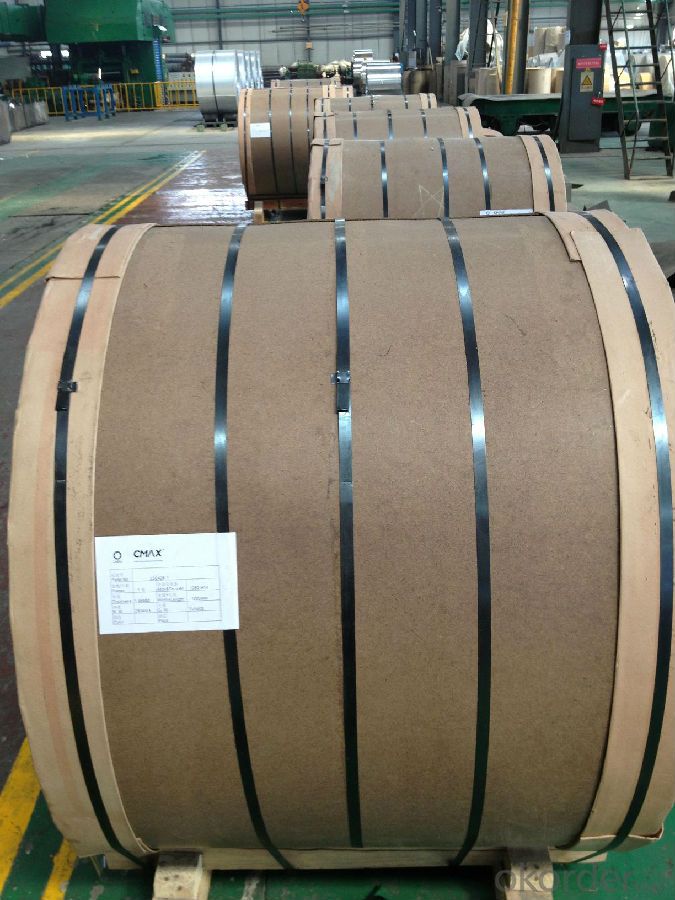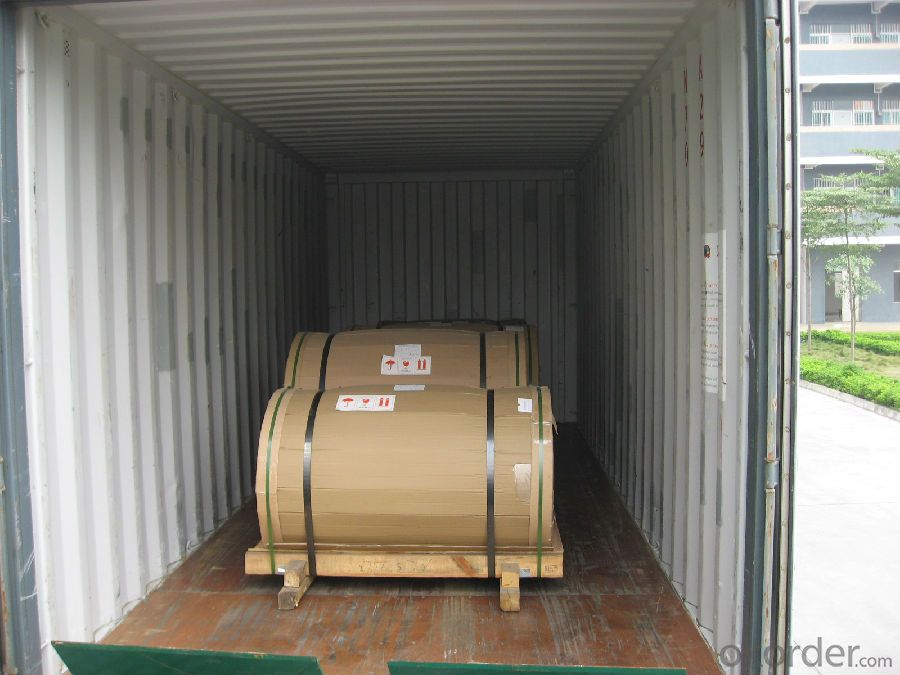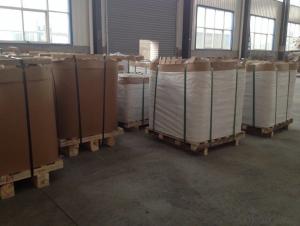Hot Rolled Aluminium Circles for Tubes AA1070
- Loading Port:
- Shanghai
- Payment Terms:
- TT OR LC
- Min Order Qty:
- 5 m.t.
- Supply Capability:
- 50000 m.t./month
OKorder Service Pledge
OKorder Financial Service
You Might Also Like
Item specifice
1.Structure of Hot Rolled Aluminium Circles for Tubes AA1070
Directing Pass Aluminium Strips for Secondly Rolling is one semi-finished aluminium material. This strip can be rolled down to aluminium coil,sheet,circle ect. The alloy AA1050 is widly used in building, industry ect. Its weight is much lower than steel. So many customers choosed aluminium material instead of steel.
2. Main features of Hot Rolled Aluminium Circles for Tubes AA1070
a.Competitive price---We have our own mills and can produce mill finished aluminium coils, so we can control the production cost better.
b.Professional after-sale service---We have more than 15 years exportation experience and you need not worry about the exporation problems.
c.Fast delivery time---We can control the delivery time within 35 days.
3. Image of Hot Rolled Aluminium Circles for Tubes AA1070



4. Product Specification
| Alloy | Temper | Thickness | Width | Weight |
| AA1070 | H14 | 0.2MM-3MM | 1000MM-1800MM | 2 TONS |
5.FAQ:
What is the quality standard?
---Usually our standard is GB3880-2006
What is the largest width?
---It is 2300mm
What is the MOQ?
---Usually we can accept 80 tons.
- Q:What are aluminum sheets made of?
- Aluminum sheets are typically made of pure aluminum or aluminum alloy, which is a combination of aluminum and other elements such as copper, magnesium, or zinc. The exact composition of the alloy depends on the specific application and desired properties of the sheet. Pure aluminum sheets are softer and more malleable, while alloyed aluminum sheets offer increased strength, durability, and resistance to corrosion. The sheets are produced through a process called rolling, where a large block or ingot of aluminum is passed through a series of rollers to reduce its thickness and create the desired sheet size.
- Q:How do you prevent oxidation of exposed edges of aluminum sheets?
- One effective way to prevent oxidation of exposed edges of aluminum sheets is by applying a protective coating or sealant. This creates a barrier between the aluminum and the surrounding air, preventing the metal from coming into contact with oxygen and moisture, which are the main causes of oxidation. Additionally, storing the aluminum sheets in a dry and controlled environment can also help minimize the risk of oxidation.
- Q:Are 101 aluminum sheets suitable for chemical transfer piping?
- No, 101 aluminum sheets are not suitable for chemical transfer piping. Aluminum is generally not recommended for handling certain chemicals due to its reactivity and potential for corrosion. It is more commonly used in industries that require lightweight materials and good thermal conductivity, such as aerospace or construction. For chemical transfer piping, it is advisable to use materials that are resistant to corrosion and can withstand the specific chemicals being transported, such as stainless steel, PVC, or high-density polyethylene (HDPE).
- Q:How do aluminum sheets perform in terms of impact resistance?
- Aluminum sheets are known for their excellent impact resistance properties. Due to their high strength-to-weight ratio, they can withstand significant impacts without deforming or breaking easily. Additionally, aluminum has inherent toughness and flexibility, which allows it to absorb and distribute the force of an impact, minimizing the risk of damage. This makes aluminum sheets a preferred choice for applications requiring durability and resistance to impact, such as in the automotive, aerospace, and construction industries.
- Q:Are aluminum sheets resistant to abrasion?
- Indeed, aluminum sheets exhibit a general resistance to abrasion. Renowned for its sturdy nature and robustness, aluminum proves impervious to scratches or harm induced by abrasion. Nevertheless, the degree of resistance may fluctuate contingent upon the particular alloy and thickness of the aluminum sheet. Sheets boasting greater thickness and higher alloy content typically offer superior protection against abrasion. Furthermore, the surface finish of the aluminum sheet can also influence its resistance to abrasion. All things considered, aluminum sheets present a dependable option for enduring abrasion in a myriad of applications.
- Q:Can aluminum sheets be used for balcony railings?
- Yes, aluminum sheets can be used for balcony railings. Aluminum is a popular material for balcony railings due to its lightweight nature, durability, and resistance to corrosion. It is a versatile material that can be easily formed into different shapes and designs, making it suitable for various architectural styles. Additionally, aluminum railings require minimal maintenance and can withstand harsh weather conditions, making them a practical and long-lasting choice for balcony railings.
- Q:How does aluminum sheet perform in extreme temperatures?
- Aluminum sheet performs exceptionally well in extreme temperatures due to its unique properties. One of the key advantages of aluminum is its high thermal conductivity, which means it can rapidly transfer heat. This property allows aluminum sheet to quickly adjust to extreme temperatures, preventing warping or cracking that can occur with other materials. Additionally, aluminum has a high melting point of around 660 degrees Celsius, making it ideal for applications in high-temperature environments. It remains structurally stable and does not lose its strength or integrity when exposed to extreme heat. Moreover, aluminum has a low coefficient of thermal expansion, meaning it expands and contracts minimally with temperature changes. This characteristic enables aluminum sheet to maintain its shape and dimensions even when subjected to extreme temperature fluctuations. Furthermore, aluminum has excellent corrosion resistance, which is further enhanced by an oxide layer that forms naturally on its surface. This oxide layer protects the aluminum from chemical reactions and prevents it from deteriorating even in harsh environments or extreme temperatures. In summary, aluminum sheet performs exceptionally well in extreme temperatures due to its high thermal conductivity, high melting point, low coefficient of thermal expansion, and excellent corrosion resistance. These properties make it a reliable choice for various applications, including aerospace, automotive, and industrial sectors, where performance under extreme temperatures is crucial.
- Q:What are the advantages of using aluminum sheets in automotive applications?
- There are several advantages of using aluminum sheets in automotive applications. Firstly, aluminum is a lightweight material, which means that using aluminum sheets can significantly reduce the overall weight of the vehicle. This leads to improved fuel efficiency and lower emissions, which is crucial in today's environmentally conscious society. Secondly, aluminum sheets offer excellent corrosion resistance. Due to its oxide layer, aluminum is highly resistant to rust and other forms of corrosion, making it a durable choice for automotive applications. This ensures that the vehicle maintains its structural integrity and aesthetic appeal over a longer period. Additionally, aluminum has excellent thermal conductivity. This property allows for efficient heat dissipation, making it suitable for applications such as radiators and heat exchangers. By effectively managing heat, aluminum sheets help prevent overheating and extend the lifespan of various vehicle components. Moreover, aluminum is a highly malleable material, which means that it can be easily formed into complex shapes and designs. This versatility allows for greater design flexibility in automotive manufacturing, enabling the creation of sleek and aerodynamic vehicles. Furthermore, aluminum is a recyclable material. With the increasing focus on sustainability, using aluminum sheets in automotive applications aligns with the industry's goal of reducing waste and minimizing environmental impact. The recyclability of aluminum also contributes to a more circular economy, where materials can be reused and repurposed. Lastly, aluminum sheets have excellent strength-to-weight ratio. Despite being lightweight, aluminum is a robust material that offers high strength and durability. This strength allows for the construction of safe and reliable vehicles that can withstand various road conditions and potential impacts. In conclusion, the advantages of using aluminum sheets in automotive applications include weight reduction, corrosion resistance, thermal conductivity, design flexibility, recyclability, and a high strength-to-weight ratio. These benefits contribute to improved fuel efficiency, durability, safety, and environmental sustainability in the automotive industry.
- Q:I have to wire solar DC photovoltaic panels and have always used at least an 8 gauge wire. Recently, I installed a solar electric fence and they recommended special electric fence wire that can handle 10,000 volts. It looks aluminum. The fence techs told me copper is only rated for 600 volts. And the power will leak through the insulation. They also say copper will corrode and created insulated spots. Does this mean that aluminum doesn't corrode and is it superior to copper? Is is all a lobbying scam to force us to buy copper? Can I use the electric fence wire in my solar wiring?
- Why in the name of G-d are solar panel installations using higher than 600 volts? I can't imagine the clearances in the panels will stand 10,000 volts without jumping arcs. It is true that the rubber insulation used on most wiring is rated at 600 volts breakdown - special neon rated wire is used for higher voltages, which can also be copper. When you say electric fence wire, you actually mean the short wires that run from the high voltage source to the end of the bare wires which are usually steel to withstand the force of animals who bump into them before the shock drives them off and which is the wire most of us think of as fence wire. There is a problem using aluminum wire, especially in houses, because it forms a hard oxide surface very quickly and expands and contracts more than copper, so it must be used with special connectors that break through the layer and grease that keeps off the air. If you are using 8 gauge wire, you are doing it because of fairly high amps, which usually involves low voltages and solar arrays I have looked into have been 12, 24 and 48 volts. If your system is putting out 30-40 amps at 600 volts, you are 18,000 watts or more through 1 set of wires. Really? Or am I mixing two systems?
- Q:The difference between aluminum plate and aluminum plate
- Aluminum row is aluminum profile! Cheapness! The manufacturing process is different. The performance of aluminum plate will be higher! I hope you can adopt it! Is there anything you'd like to inquire about?!The data from Suzhou Juteng Metal Technology Department
1. Manufacturer Overview |
|
|---|---|
| Location | |
| Year Established | |
| Annual Output Value | |
| Main Markets | |
| Company Certifications | |
2. Manufacturer Certificates |
|
|---|---|
| a) Certification Name | |
| Range | |
| Reference | |
| Validity Period | |
3. Manufacturer Capability |
|
|---|---|
| a)Trade Capacity | |
| Nearest Port | |
| Export Percentage | |
| No.of Employees in Trade Department | |
| Language Spoken: | |
| b)Factory Information | |
| Factory Size: | |
| No. of Production Lines | |
| Contract Manufacturing | |
| Product Price Range | |
Send your message to us
Hot Rolled Aluminium Circles for Tubes AA1070
- Loading Port:
- Shanghai
- Payment Terms:
- TT OR LC
- Min Order Qty:
- 5 m.t.
- Supply Capability:
- 50000 m.t./month
OKorder Service Pledge
OKorder Financial Service
Similar products
New products
Hot products
Hot Searches
Related keywords





























